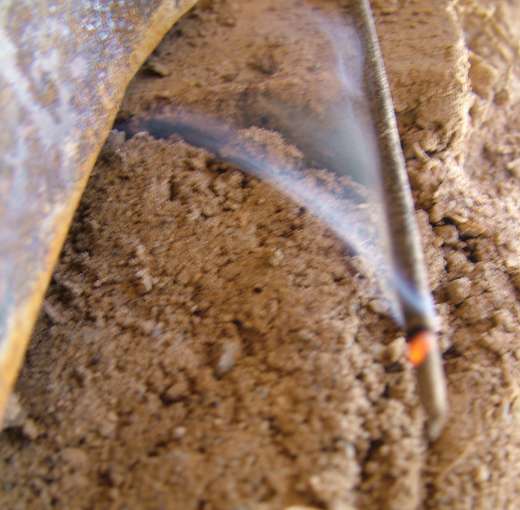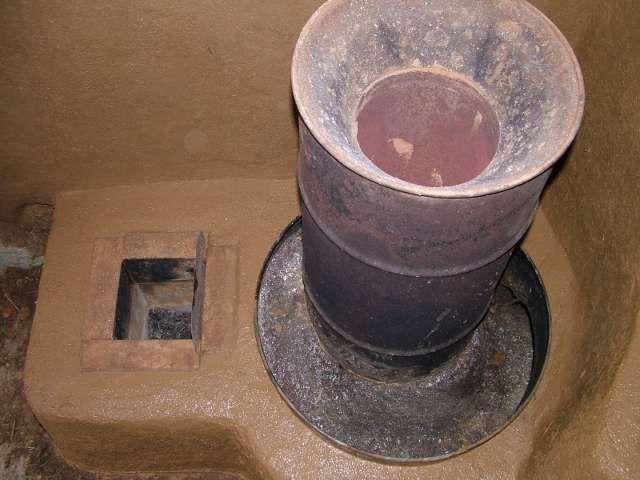|
|
Post by Donkey on Feb 8, 2013 14:48:32 GMT -8
I've been building a stove for a friend.. There isn't much space for a long bench on this RMH, so I decided to built over a half barrel, (thank you matthewwalker) thinking that a bell would capture more heat in less space.. I built up the sides first, then placed the half barrel on; it seems right to make the bell taller. Before sealing the thing in, I wanted to test the idea a little, so I tossed on the half barrel and started up the stove.  It started very quickly (for an utterly wet stove), smoking out of the seams for a couple minuets, which I expected. As I was reaching for a little wet cob to shmeer around the seams for a temporary seal, I saw the leakage reverse itself, suddenly drawing inward. The edges around the half barrel are just loosely setting on a lip, the barrel's ends are FULL of holes and all of the holes and seams were drawing inwards!  I had to get a picture of this to show as proof..   Very cool. ;D |
|
|
|
Post by Donkey on Feb 8, 2013 14:54:26 GMT -8
Oh.. The bench has since been built up, with a high back that can also be sat on (feet on the hotter lower level). It got a base plaster layer yesterday too.  |
|
|
|
Post by Donkey on Feb 8, 2013 15:02:11 GMT -8
Also.. Here's another way to do the heat riser/manifold/barrel connection thing..  |
|
|
|
Post by mechartnik on Feb 8, 2013 16:20:25 GMT -8
bellisimo!
|
|
|
|
Post by peterberg on Feb 9, 2013 1:59:23 GMT -8
As I was reaching for a little wet cob to shmeer around the seams for a temporary seal, I saw the leakage reverse itself, suddenly drawing inward. The edges around the half barrel are just loosely setting on a lip, the barrel's ends are FULL of holes and all of the holes and seams were drawing inwards!  Right, Donkey. That's on a par what I've found out about the batch box design. Igor Kusznetsov stated somewhere there would be over pressure in the bell construction, rising together with temperature. So I've tried that, the Testo 330 is able to measure draw. Not only as under pressure but over pressure as well. So I drilled an 8 mm hole low in the side of the barrel to accept the sensor. Starting from cold an ever so slight overpressure was building up. After 3 or 4 minutes, it changed to under pressure, rising with the temp. During the entire run, it stayed that way. This small vacuum happened to be all over the stove, wherever I inserted the sensor. So Igor was wrong about this, it's only a theory, no measurements has been done by him, obviously. As a hind sight, the chimney is drafting, generating under pressure. The whole phenomenon seem to be contrary to what you would expect. The gases are expanding about to a factor four and the water, which is a by-product of burning wood gas (like natural gas) is expanding between 400 and 500 times. And still there's no over pressure except for the first couple of minutes in the burn. One good thing: when the stove is drafting properly, there won't be any leakage to the room. The Testo has always been close to the stoves, measuring ambient CO all the time. There's never been a warning of rising CO levels when the stove was running healthy. |
|
|
|
Post by Donkey on Feb 9, 2013 10:37:16 GMT -8
I've seen this in benches using stovepipe too. When the clean-out port(s) get opened up during a burn, I don't think I've ever seen over pressure.. As far as I can remember, the ports ALWAYS seem to draw inward once the stove is running properly.
|
|
|
|
Post by matthewwalker on Feb 9, 2013 12:22:10 GMT -8
That is a beautiful build Donkey. I like the way you've done the transition there, very tidy. Did you build a hollow beneath the half barrel? It looks like it's got a lot of volume, like you used the half barrel as a domed top to a larger chamber. Cool.
Great photo of the smoke being drawn inward. I've been impressed with that phenomenon for a while now. When I build my temporary outdoor half barrel benches, it's amazing how crappy they can be and still not smoke at all. A few handfuls of mud at the big gaps and you're good to go.
|
|
|
|
Post by Donkey on Feb 9, 2013 16:08:45 GMT -8
Yeah, I built it up a little over a foot before putting on the half barrel. It makes for an unusually high bench, but it seems worth it for the extra bell space.
What a cool system, I really like the half-barrel thing! Thanks for that!
|
|
dvawolk
Full Member
   DSR2 125mm open system (actual project)
DSR2 125mm open system (actual project)
Posts: 273
|
Post by dvawolk on Feb 10, 2013 0:50:35 GMT -8
Underpressure? First i thought it is happening because of chimney draft combined with faster cooling because of metal surface exposed to room temperature. But when Peter stated those figures of large expanding at the beginning it would look i just cant get it...
But it is great that way! A black oven came to my mind again: if there is under pressure in the first bell when the stove is running well, would it be enough of it for the gases to stay generally inside of the first bell when i would open the black oven doors?
Arghhh and when i was writing it came to my mind that the "first bell" is actually a substitute for a barrel in regular RMH so i really doubt that there would be under pressure also... Peter - do you mean "all over the stove" literally everywhere?
Klemen
|
|
dvawolk
Full Member
   DSR2 125mm open system (actual project)
DSR2 125mm open system (actual project)
Posts: 273
|
Post by dvawolk on Feb 10, 2013 0:54:23 GMT -8
Oh, and, Donkey:
I like the finish of it - i just got myself first batch of local clay and i started testing it clay:sand from 3:1 to 1:3. I think that 1:1 and 2:3 are the best candidates. If i add more sand then i can abrade sand with my hand from dry testing bricks... None of them cracked, BTW. Maybe they were too small (1 3/4" x 8" x 4")??
Clay is really a great material!
Klemen
|
|
|
|
Post by grizbach on Feb 10, 2013 9:17:38 GMT -8
Very nice Donkey, It would be fun to spend some time in one of those earth buildings with a mass heater.
I need to ask my standard question, what is flue temp is on this build?
Since you built a cavity below the half barrel, Do you think It would have been easier to just place the whole barrel in the cob? It would only need 2 ports cut into it.
|
|